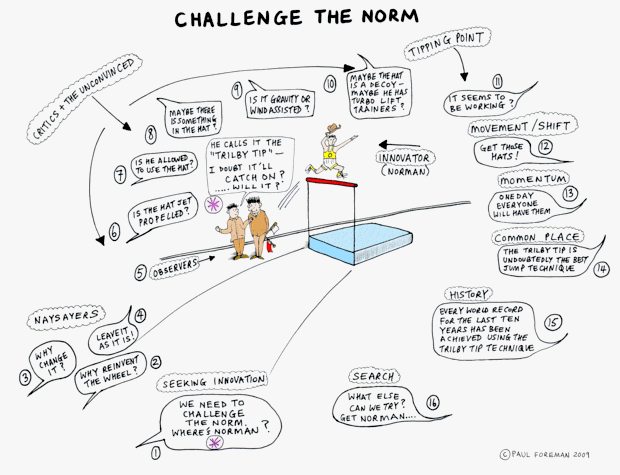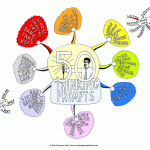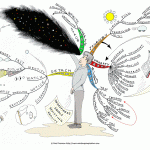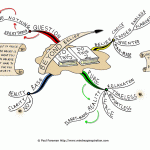The Commentate Your Activities Mind Map covers how you can hone and fine-tune your everyday tasks by using an internal commentary.
Commentating your activities is similar to a “How to” instruction video only you get to be the producer, director and presenter. You could pretend you are creating a documentary or teaching course on your activity and create a walk-through or talk-through demonstration covering every single angle. The commentary works well internally although you could talk your way through for real.
Creating an internal talk-through of your activities
Imagine you are an expert on your subject (perhaps you are) and simply talk your way through what you are doing. You can even adopt the technique for basic everyday chores; example, cutting a carrot. By talking your way through what you are doing there is a greater depth to the activity and you will be more aware in the present moment. This could prevent cutting a finger!
In addition to a commentary you could further explore your activity by using radial thinking and vision. Try 360° thinking – ponder links and associations to further enrich the activity. Cutting a carrot? Notice the mud, texture, surface, colour, heat – enhance your senses – consider the growing of the carrot, delivery, shipping, shopping, and ways to cook. How might you cut, dice, eat and serve the carrot. What else could you use a carrot for? Who first tried eating one? What would you call a carrot if it were a cartoon character or superhero?
Visualization and imagination
You might combine your commentary with a walking meditation or visualization such as an athlete picturing in their mind a high jump technique. For example, visualise in your mind tying your shoe laces and talk your way through the activity in your mind before trying to tie your shoelaces. We do so many things automatically it can be quite difficult to explain each step when breaking tasks down, yet often talking through the stages encourages new thinking and ways of seeing.
When you commentate your activities, to add a twist you can imagine in your mind the voice of your favourite actor or singer; perhaps an inspirational teacher or tutor. Try different styles: for example, you could sing your activities in Opera or Reggae or any other genre to add a fun element and get you thinking differently.
Use your imagination to explore and combine potential ideas and new ways of working. Example: when using my mouse at my computer, what if I could hit a switch, pick it up and use it as a pointer on the screen? Operate it in mid-air and point to areas on the monitor.
When I drink a bottle of water, could there be a pull strip at the bottom that allows me to add a flavour and shake?
Commentate on the activities of others
You can apply the idea to other people, when watching television or being tutored on a course – have they covered everything and revealed the basic 5W 1H questions? Jot down notes and ask questions.
Bringing depth and richness to the experience
As you commentate your activities ponder each action – are there easier, better, faster ways of doing what you do? Could you improve what you are doing by slowing down? Often rushing creates more work because you end up having to undertake the task again! View the end result and consider efficiency, simplicity and user-friendly elements.
Asking “I wonder what would happen if?” helps you ponder alternatives and unearth new innovative ideas. For example, if you are a program developer you can speak your way through your application to see how a user might tackle each step:
What might someone with zero knowledge do when using your design? You may have to ask someone totally new to talk through the steps to see how they use the system. Think of minute detail: What have you assumed? What might you have overlooked? What could you improve? How easy are the users finding the system? Think of the driving position in cars; you are seated and everything you need is at hand for both convenience and safety; could you create a more user-friendly system in your activity?
Challenge the norm
When using an internal commentary of activities, you may be able to challenge the norm and consider innovative solutions to any procedures that are not quite as efficient as they could be. Often new ideas seem crazy before they become successful.
Enhancing awareness
The commentary technique is used in advanced driver training – next time you drive, try it! Talk your journey. Notice signs, pedestrians, danger zones and potential hazards. Analyse your driving skills and adjust techniques and speeds.
Side note and three quick driving tips:
1. Keep a disposable camera in your glove box in case of accidents – handy for insurance claims
2. When reversing, try keeping your steering wheel straight and you will be able to reverse in a straight line
3. Observe feet of pedestrians and animals by looking underneath parked vehicles
Using the commentate your activities technique you will be amazed at the depth of your existing knowledge. It develops an enquiring mind to question what you are doing rather than being on autopilot. You will be able to highlight potential improvements and bring more awareness and enjoyment to everyday tasks. Try it with basic operations such as lifting a pencil and drawing or writing, raising a cup to drink, eating, walking, everything! No silly questions exist – exploring why we do things helps uncover new possibilities. Questions are the forerunners of progress a future Mind Map will cover this 🙂
Back to the moment
Ask a great question: “What am I doing?” The question is a good pointer to use when trying the Commentate your Activities technique. Come back to the present moment and “feel” what you are doing with greater awareness.
I hope the above ideas help you – have fun experimenting.
More from Mind Map Inspiration:
Submit your review | |









